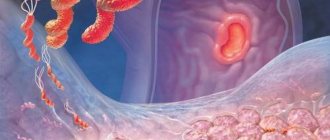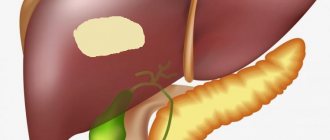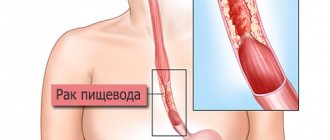In modern medicine, it is customary to distinguish between functional dyspepsia (FD) and organic dyspepsia (dyspeptic syndrome in various diseases of the digestive tract). If in the first case it is a separate chronic pathology, then in the second it is a symptom complex that accompanies a large number of organic gastrointestinal diseases. “Dyspepsia” is translated from Greek as “digestive disorder or disorder”, which every person has encountered at least once in their life.
Concept and causes of functional dyspepsia
FD refers to periodically occurring pain or a burning sensation in the upper segment of the abdomen, rapid saturation with food, and a feeling of severe fullness in the stomach. Previously, this concept also included: flatulence, vomiting, belching, heartburn, frequent diarrhea (indigestion) and constipation.
The diagnosis of functional dyspepsia is made based on two mandatory criteria:
- The listed symptoms should bother a person for 3 consecutive months, with a total duration of six months.
- Absence of organic damage to the digestive system (as proven by laboratory and instrumental examination methods).
The etiology of functional indigestion is not fully understood, so FD is considered a heterogeneous disease, during which several pathogenetic mechanisms are realized. All of them lead to the appearance of characteristic clinical complaints on the part of the patient.
Diagnosis criteria
Factors that provoke the development of non-organic dyspepsia:
- Impaired motor function in the upper parts of the digestive tube - in the stomach and duodenum. The majority of those suffering from FD exhibit coordination disorders between the antrum and fundus of the stomach, slower distribution and digestion of food; dysfunction of the muscular lining of the stomach during the interdigestive period.
- Visceral hypersensitivity is a significant increase in the sensitivity of the gastric mucosa to stretching by food. Therefore, many patients complain of an earlier feeling of satiety, fullness, and a feeling of fullness in the epigastric region itself.
- Hypersecretion of hydrochloric acid is one of the leading factors in the occurrence of functional type dyspepsia.
- The presence of Helicobacter pylori infection in the stomach. As is known, H. Pylori can provoke not only the development of chronic hyperacid gastritis and peptic ulcers, but also weaken the postprandial motor function of the stomach, disrupt the evacuation of the bolus, and affect the synthesis of hydrochloric acid.
- Recent acute infections of the gastrointestinal tract (in particular, giardiasis and salmonellosis).
- Psychological problems (sleep disorders, depression, anxiety) often act as unique triggers that disrupt the functioning of the central nervous system and gastrointestinal tract.
Since motor dysfunction plays a leading role in the pathogenesis of dyspepsia, this disease is also popularly called “sluggish or lazy stomach.”
Diet
Every year, people increasingly began to think about how to make their stomach work. Many people do not even suspect that the health of the digestive system depends on what and how we eat. If you still don’t eat right, but want to start leading a healthy lifestyle, you need to act without fanaticism. To begin with, gradually reduce your portions and chew your food more thoroughly.
Solid, heavy foods are much less digestible, so a “lazy stomach” will never want to start working. Be sure to follow the regime. Eat at the same time every time. Half an hour before meals, drink a glass of water. This procedure will make your digestive system work smoothly.
Eat the most high-calorie foods for breakfast and lunch. For dinner, doctors recommend only light, low-calorie foods.
Don't forget about fasting days. This does not mean that you will have to starve. Do not do this under any circumstances. Eat only light foods. For example, fruits, vegetables, kefir and fermented baked milk. This way your stomach will take a break from heavy food and take up its work with renewed vigor.
A diet for functional dyspepsia is always prescribed. You need to eat in small portions (about 200 g) 5-6 times a day. This will help keep your stomach working continuously without overstraining it. You need to eat slowly, chewing pieces of food well. It is better to refuse food before going to bed. The last meal should be 2-3 hours before bedtime.
The diet for dyspepsia is not strict, but it will help cope with the problem and prevent recurrence.
Solid, heavy foods are much less digestible, so a “lazy stomach” will never want to start working. Be sure to follow the regime. Eat at the same time every time. Half an hour before meals, drink a glass of water. This procedure will make your digestive system work smoothly.
Classification and symptoms of FD
According to the modern classification (FC), functional dyspepsia is divided into 2 types:
- Painful epigastric syndrome (ulcer-like variant).
- Postaprandial distress syndrome (dyskinetic variant).
FD classification
The ulcer-like variant of the disease is characterized by a feeling of intense burning (heat), interspersed with aching or acute pain, which are localized in the upper segment of the abdomen. It is noteworthy that these phenomena do not disappear after bowel movements or the release of gases.
The dyskinetic type of pathology is characterized by a feeling of pronounced fullness in the epigastric zone itself after eating a portion familiar to a person, and earlier saturation due to the low threshold of sensitivity of the gastric wall to stretching by food. All this prevents the normal completion of a meal, eating a full portion, and occurs three or more times a week.
Functional indigestion can occur together with heartburn (as a manifestation of gastroesophageal reflux disease), flatulence and bowel dysfunction (which is included in the concept of irritable bowel syndrome).
Diagnosis and treatment
Since functional dyspepsia is a diagnosis of exclusion, when characteristic symptoms appear in a patient, a comprehensive examination is indicated.
To confirm the diagnosis, the patient undergoes examinations:
- clinical blood test, general urine test;
- biochemical analysis of peripheral blood;
- coprocytogram;
- sonographic scanning of the abdominal organs;
- FEGDS – fibroesophagogastroduodenoscopy, during which morphological changes in the epithelial membranes of the esophagus, stomach and the initial part of the duodenum are excluded;
- urease test for the presence of H. Pylori contamination.
After all possible organic pathology has been excluded, treatment begins.
Note. A history of chronic gastritis or peptic ulcer does not exclude the possibility that the same patient may have functional dyspepsia as an independent disease.
Treatment of patients with FD is always complex and consists of several stages:
- Normalization of lifestyle (improving daily routine, increasing time for rest, eliminating stressful situations and unpleasant communication, including dosed physical activity);
- Getting rid of bad habits such as smoking and drinking alcohol.
- Dietary recommendations: switch to fractional meals, in which you need to eat 6-7 times a day, in small portions. It is important to consume fat-containing foods, fried, spicy and smoked foods as little as possible.
- Prescribing medications.
Drug therapy may consist of several types of drugs:
- PPIs - proton pump inhibitors (Lansoprazole, Omeprazole, Nolpaza). Their main function is to reduce the production of hydrochloric acid by the parietal cells of the gastric mucosa. In some cases, even half the dose of the drug per day is effective.
- H2-histamine receptor blockers (ranitidine, famotidine) are sometimes used together with PPIs. The medicine is used twice a day.
- When H. Pylori is detected, eradication therapy is mandatory. It consists of taking two antibacterial drugs and one antacid for two weeks.
- To normalize motor function, prokinetics (metoclopramide, domperidone) are used.
- Some patients are prescribed sedatives and tricyclic antidepressants in small doses (diazepam, amitriptyline).
Psychotherapy and acupuncture sessions are highly effective.
Traditional methods
Treatment of a lazy stomach with folk remedies can only be carried out after consultation with a doctor. Plants contain a lot of active components, so self-medication can be dangerous. Traditional healers recommend making medicines that coat the stomach and have anti-inflammatory effects. Medicinal plants, dried fruits, seeds, etc. can be used. Treatment of infants with folk remedies is strictly prohibited due to the high probability of developing an acute allergic reaction.
Dried fruits
To activate a lazy organ, folk remedies use a collection of dried fruits. Dried apples, raisins, dates, prunes, dried apricots, and figs are suitable for its preparation. You will need 100 g of each component. The ingredients are washed and poured with boiling water for a few minutes (they should steam). After this, you need to grind the dried fruits (it is convenient to do this with a meat grinder). It should be a paste. Next, you need to add 100 g of honey, nuts, flaxseeds and mix all the ingredients thoroughly. It is recommended to take the medicine in the morning on an empty stomach 30 minutes before meals and before going to bed (5 g each).
Flax seeds
Flaxseeds can help your stomach work. An infusion must be prepared from them. To do this, pour 20 g of seeds into 200 g of chilled boiled water overnight. In the morning you need to add raisins (pre-rinse and pour over boiling water), grated carrots and 20 g of honey. The ingredients should be mixed well. It is recommended to take the medicine twice a day on an empty stomach. Flax seeds can be used in another recipe. 20 g of seeds are poured on the floor with a glass of chilled boiled water overnight. In the morning you need to pour in 20 g of honey, yogurt, and fruit juice. You need to take 100 g of the medicine in the morning on an empty stomach.
Chamomile and other plants
Chamomile can be brewed instead of tea. To do this, 10 g of dried flowers are steamed with 200 g of boiled water and allowed to stand for half an hour. After this, the tea needs to be strained and drunk. You can add chamomile to regular green tea. It is useful to use mint, St. John's wort, and sage in this way. The medicine must be taken warm to enhance the effect. It is permissible to mix chamomile with calendula and St. John's wort. To do this, you will need up to 10 g of plants, which are steamed with boiling water (200 g) for half an hour. You need to drink the infusion 4 times a day.
What is dyspeptic syndrome and the reasons for its occurrence?
The main differences between organic dyspepsia (impaired digestion) and functional dyspepsia are the obligatory presence of gastrointestinal pathology and a wider range of symptoms.
Symptoms of organic dyspepsia
Dyspeptic syndrome can be observed in the following diseases:
- chronic gastritis, gastroduodenitis, peptic ulcer of the duodenum or stomach;
- chronic cholecystitis;
- acute and chronic form of pancreatitis;
- inflammation in the intestinal wall (colitis);
- acute intestinal infection;
- tumor processes in the organs of the digestive system.
Manifestations of dyspepsia syndrome
Symptoms of organic dyspepsia can come to the fore or be accompanying.
These include:
- heartburn, belching, unpleasant taste in the mouth;
- nausea, vomiting;
- painful sensations in the abdomen;
- excessive gas formation in the intestines (flatulence);
- bowel disorder in the form of diarrhea or constipation;
- constant feeling of fullness and lack of appetite.
Diagnosis and treatment of the syndrome
The diagnosis of the underlying disease comes to the fore, which may include various studies:
- detailed blood test (shows the presence of inflammation in the body);
- biochemical study of the patient’s blood serum (most specific for cholecystitis, pancreatitis);
- coprocytogram, bacteriological examination of stool;
- FEGDS – for morphological verification of the diagnosis;
- Ultrasound of the abdominal cavity, which includes the liver with the gallbladder and ducts, pancreas, spleen.
Treatment is aimed at the underlying disease and relief of unpleasant symptoms of dyspepsia with the help of diet and medications. It may include antibacterial drugs, pancreatic enzymes, antacids, prokinetics, proteolysis inhibitors, sorbents, probiotics, choleretic drugs and hepatoprotectors.
After complete recovery (for example, with an intestinal infection) or the disease goes into remission, the manifestations of dyspeptic syndrome also disappear.
Diagnostic measures
If the stomach does not want to function fully, then you need to urgently seek help from a doctor. The doctor will ask about any complaints, conduct an external examination, and then prescribe an examination.
- donating blood for general and biochemical analysis;
- delivery of urine and feces to detect impurities and bacterial agents;
- conducting an X-ray examination using a contrast agent;
- performing ultrasound diagnostics of the abdominal organs;
- carrying out manometry and scintigraphy.
Fibro- and phagogastroscopy is considered one of the mandatory types of diagnostics. Such techniques allow you to fully examine the organ from the inside. To identify the cause of a functional disorder, gastric juice is examined. This will help determine the acidity level and take the right measures.
Answers on questions
What is a “clogged stomach”?
There is no such term in medicine; most likely it is used by the common people. However, a person can feel such a feeling of heaviness in the stomach after overeating, against the background of functional dyspepsia.
Disruption of digestion processes is observed during exacerbation of chronic gastritis and peptic ulcer. In addition to heaviness, a person may be bothered by nausea and belching.
If the feeling of “clogging” of the stomach recurs regularly, it is necessary to undergo an appropriate examination: FEGDS, ultrasound. It is also important to follow the principles of proper nutrition to ease the work of the gastrointestinal tract: eat small portions, 3-5 times a day, avoiding spicy, fried foods, and fast food.
The doctor said that I have impaired gastric motility. What does it mean?
Gastric motility is the sequential contraction of muscle fibers for the purpose of grinding and moving food into the small intestine. If it is disrupted, food is poorly ground into chyme and remains in the lumen of the stomach for a long time, which negatively affects the absorption of vitamins and essential nutrients. In addition, rotting processes are started. Some people also call this condition “sluggish stomach.”
If the motility of the gastrointestinal tract is impaired, the following complaints may appear:
- feeling of heaviness in the upper abdomen;
- discomfort after eating;
- nausea, less often – vomiting;
- belching with a putrid odor.
The diagnosis is confirmed by gastroscopy (FEGDS), in which the doctor detects sluggish peristalsis, cloudy greenish or dark yellow contents in the stomach. Treatment depends on the pathology. Prokinetics are used to normalize motor function.
https://youtu.be/ra5SN2VxoDs
Prevention
You can prevent the symptoms of “lazy stomach” syndrome by following simple rules of nutrition and lifestyle:
- daily introduce into the diet foods containing a large amount of fiber (cereals, vegetable dishes, fresh fruits and vegetables);
- limit the intake of fatty and difficult-to-digest foods, do not allow the daily dose of fats (especially animals) to exceed 50 mg;
- do not eat heavily before bed, it is advisable not to eat 2 hours before expected sleep;
- Allow your body to cleanse itself of heavy food one day a week. On a fasting day, you can drink mineral water, eat light food (kefir, broth, juices, etc.);
- Drink still mineral water on an empty stomach and maintain plenty of drinking water throughout the day;
- adhere to an optimal motor regimen with evening walks and physical exercises during the day. Mood and physical activity improve the functioning of the digestive organs;
- limit the consumption of alcoholic beverages, stop smoking;
- learn how to quickly and optimally get out of stressful situations that are a stupor for normal digestion.
A “lazy stomach” will stop frequently giving out whims if you follow the above set of recommendations.
Folk remedies for disorder
Traditional medicine recipes are aimed at the timely start of the digestive process, so most drugs are taken on an empty stomach. For example, flaxseeds at the rate of 2 small spoons per glass of water are poured with cold boiled water. In the morning, the seeds are mixed with 1 grated carrot root and raisins, scalded with boiling water the day before. Add 1 large spoon of honey to the mixture, take a large spoonful of the mixture on an empty stomach.
In addition to a mixture of flaxseeds with the indicated ingredients, these same seeds can be combined with curdled milk, honey and fruit juice. There are known mixtures for improving gastric activity based on chamomile flowers, dried fruits from figs, dried apricots, raisins, apples, etc.
RepostTweet











